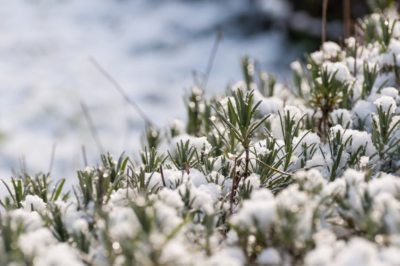Many a gardener wonders in the spring why the supposedly hardy lavender did not survive the last winter and froze to death. In fact, when wintering this rather less hardy plant – even if some guidebooks say otherwise – you can do quite a lot wrong. Among the most common mistakes are a wrong choice of varieties, wrong location, lack of winter protection or too frequent / wrong watering. In very cold but sunny winters, lavender also runs the risk of drying out.

Contents
Winter hardy, hardy or frost hardy?
First of all, when buying young lavender plants, you should pay very close attention to the specified designations regarding winter hardiness or frost hardiness. Many an uninformed garden center employee also confuses the terms “hardy” and “winter-hardy” and thinks they mean the same thing. However, this is wrong, because especially hardy varieties are hardly suitable for overwintering in the garden. Plants that can only withstand temperatures below freezing for a very short period of time are also referred to as hardy – but they will freeze to death during longer periods of frost even if they are well protected. Instead, go for hardy or frost-hardy varieties; these are much less sensitive to stress from permafrost and fluctuating temperatures.
It depends on the climate zone
However, even the classifications “winter-hardy” and “frost-hardy” are no guarantees that your plants will survive the winter unscathed. After all, “winter” does not mean the same thing in every part of Europe. Europe is divided into a total of seven cold zones, and the lowest temperatures can vary quite a bit. So, if a lavender plant can be left outdoors in wine-growing zones without worry, in some parts of Bavaria or on the coast it will barely survive the low or wildly changing temperatures. In this context, it is important to know that frost hardiness and winter hardiness also do not mean the same thing. Frost-hardy plants survive even prolonged periods of low temperatures quite well, but hardly strongly fluctuating climates.
Hardy varieties for the garden
This is especially true of hardy lavender, which may tolerate lower temperatures but has difficulty tolerating wildly fluctuating ones. Lavender is accustomed to a Mediterranean climate, which includes more or less constant climates than the drastic temperature drops and weather changes typical of parts of Europe. Therefore, even with hardy lavender varieties, be sure to provide good insulation to protect the plants. Only the varieties of true lavender are considered hardy – and thus suitable for planting out in the home garden. This originates from mountainous regions between 600 and 1600 meters above sea level and is therefore more robust. The following varieties have proven themselves in European gardens:
- Hidcote Blue
- Munstead
- Miss Katherine
- Imperial Gem
However, this lavender in the winter should be in a sheltered, that is, not drafts, because the plants do not tolerate (strong) wind.
Which lavender varieties are not hardy?
All other lavender varieties are not winter-hardy, although the spike lavender as well as the lavandin are considered at least partially winter-hardy. However, these plants should be better overwintered in a cold house, as well as the neither winter-hardy nor hardy Schopflavendel. Also not suitable for overwintering outdoors are the wool lavender as well as the fern-leaved lavender.
Proper wintering of hardy lavender
From autumn – ergo in September / October – you should cover planted lavender with brushwood or leaves if possible. Special insulating cold protection mats such as coconut or fleece mats are also well suited. This is especially true for the more delicate young plants; perennial lavenders are more robust in this regard. The cover not only protects the plants from the cold, but also from too much moisture – even in winter, waterlogging is deadly for lavender. Therefore, you should water only when the ground is not frozen and the water can drain appropriately. If the lavender is covered with snow, you should not remove it in any case – the snow cover protects plants from the cold.
Do not prune lavender too late
For many garden plants, autumn pruning is part of the preparation for winter – but not for lavender. This may be pruned for the last time no later than the beginning of August, as the withered stems form a natural protection against the cold for the winter. Late pruning also unnecessarily robs the plant of energy, as many varieties begin to bloom once again afterwards.
Be careful with frost and sun
Even the sun can be dangerous to the actually sun-hungry lavender in winter. Especially at temperatures around freezing, the moisture from the leaves and soil on sunny days evaporates faster than the plant can absorb the water. In this case, the plant is in danger of drying out, so you should regularly check it for signs of this and act accordingly. Lavender also does not like permafrost and then needs good protection from plant mats – especially if there is no snow.
Tips & Tricks
Scallion lavender is always more susceptible than planted lavender, so different rules apply to it. If the pots are to be left outside (and possibly only brought inside for a short time), you can wrap them with protective mats and cover the lavender itself with brushwood.

